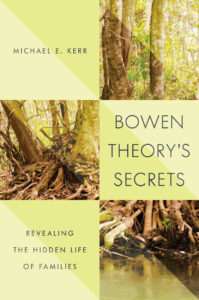
Reviewed by Stephanie Ferrera, M.S.W.
For five years, 1954 to 1959, at the National Institute of Mental Health, psychiatrist Murray Bowen conducted a most unusual research project, focused on schizophrenia. Adult patients and their parents were hospitalized together for observation and treatment. The intensity of the emotional process in these families—the sensitivities, reactivity, and the profound influence of family members on one another’s functioning–came into view. Like a powerful undercurrent, this emotional system was guiding family interaction but was largely out of the awareness of the members. It is aptly called “the hidden life of families.”
By the 1960s, seeking to move toward a theory of human behavior based on the natural sciences, Bowen had developed the core concepts of his theory and was teaching at Georgetown University School of Medicine. In a department of psychiatry focused primarily on individual intrapsychic dynamics and rooted in psychoanalytic theory, Bowen represented a radically different view: the family, not the individual, was the emotional unit in which psychiatric illness would best be understood. In a department where the family was viewed as the cause of emotional problems, “so it is the last place you want to go to try to work out these problems” (p. 175), Bowen was coaching residents to engage their families directly as the best place to observe their own emotional functioning and develop greater maturity.
Into this department came Michael Kerr as a young resident. In his first encounters with Dr. Bowen, Kerr was struck with how the ideas made sense. For many who discover this theory, the first thing that captures interest is how well the theory describes one’s own family experience. Kerr began clinical supervision with Bowen in May 1969. Six months later, Kerr’s older brother who had been diagnosed with schizophrenia, committed suicide. Bowen became a crucial resource for Kerr in dealing with this tragic event and in his effort over years to see it in the context of his own multigenerational family system.
The relationship between Drs. Bowen and Kerr evolved from a mentorship to a close and fruitful collaboration. Kerr pursued his own study of science, with special focus on biology, evolution, neuroscience, and medicine. His knowledge of theory deepened as he made presentations and wrote numerous articles and book chapters. In 1988, his first book, Family Evaluation, was published. It is an overview of Bowen theory placed in the context of the natural systems in which the human family is embedded. It quickly became a key resource for clinicians and other learners. Kerr’s part of Family Evaluation is followed by Dr. Bowen’s Epilogue, his last major writing in which he reflects on the theory and his “odyssey toward science.” In October 1990, two years after the publication of Family Evaluation, Bowen died. Kerr succeeded him as Director of the Bowen Center for the Study of the Family.
Now, thirty years later, Kerr offers this remarkable book, revealing the “secrets” of Bowen theory in a way that only he could do. My first impression was that the book is all encompassing, meaning that it contains the full depth and breadth of what Kerr knows from years of immersion in systems thinking, science, clinical practice, and life experience. Here are a few highlights:
- A review of the theory’s core concepts, enriched by many references from the natural sciences, many examples of the parallels between emotional process in humans and emotional process in other species;
- A comprehensive, nuanced, detailed presentation of the process of differentiation with all of its complexities and its pitfalls;
- Kerr’s investigation into “families in the public eye,” four case studies of people who manifested extreme emotional and behavioral disturbance: three who committed heinous murders and one who was a genius mathematician while suffering with schizophrenia from which he eventually recovered. Using the available public records to construct the family data, Kerr traces the family emotional process in each case. One comes away with a far more comprehensive and complex understanding of seemingly inexplicable behavior than is possible with a narrower focus on individual characteristics and pathology.
- Unidisease: a proposed new concept in Bowen theory. Kerr’s interviews with cancer patients and their families, plus his extensive study of the biology of cancer and several other diseases, led him to see the number of physiological processes they have in common. The unidisease concept describes the continuity between chronic anxiety generated in the family and the chronic-anxiety driven stress response involved in most illnesses. Kerr cites many findings in medical research that are consistent with the unidisease hypothesis, but notes that “the toughest issue remains, which is proving the link between chronic anxiety in a family system and psychological and physiological processes of individual family members.” (p. 321)
Bowen theory is not an “ivory tower” set of abstractions, but a living theory with a level of usefulness that can be life-changing. Kerr demonstrates that usefulness with clinical vignettes to illustrate particular points in the theory, with a composite in-depth clinical case study, and most importantly with the study of the family he knows best—his own. He refers to his own family at many points and ends the book with an epilogue, “Applying Bowen Theory to My Own Family.” The reader might be curious about Kerr’s decision to do this, but it proves to be a most effective way of teaching the theory and the way theory guides the effort toward differentiation, maturity, and responsibility. Following Kerr’s thinking, one sees how objectivity and blame-free neutrality emerge as one gains a broader understanding of chronic anxiety playing out across generations through repeating patterns, impacting the emotional functioning of each member to different degrees. As he learned more, Kerr saw more clearly the total family involvement, including his own part, in the emotional process that led to his brother’s impairment and suicide. With this perspective, one can only respect the power of the family emotional system.
This hidden emotional system, with its comforts and its constraints, is what we live in every day, instinctively knowing its presence and feeling its pressures, but lacking the perspective to bring it into focus and awareness. Murray Bowen’s elegant theory poses a challenge to those who would discover its secrets. It requires one to develop the discipline of systems thinking in a world that operates largely on cause-and-effect thinking, and to acquire the knowledge needed to see human nature in the context of evolution. For those who are up for the challenge, Michael Kerr’s masterful presentation of Bowen theory offers serious, essential, and most trustworthy guidance.




I think Stephanie Ferrera’s review is a superb assessment of what I was trying to accomplish with this book.